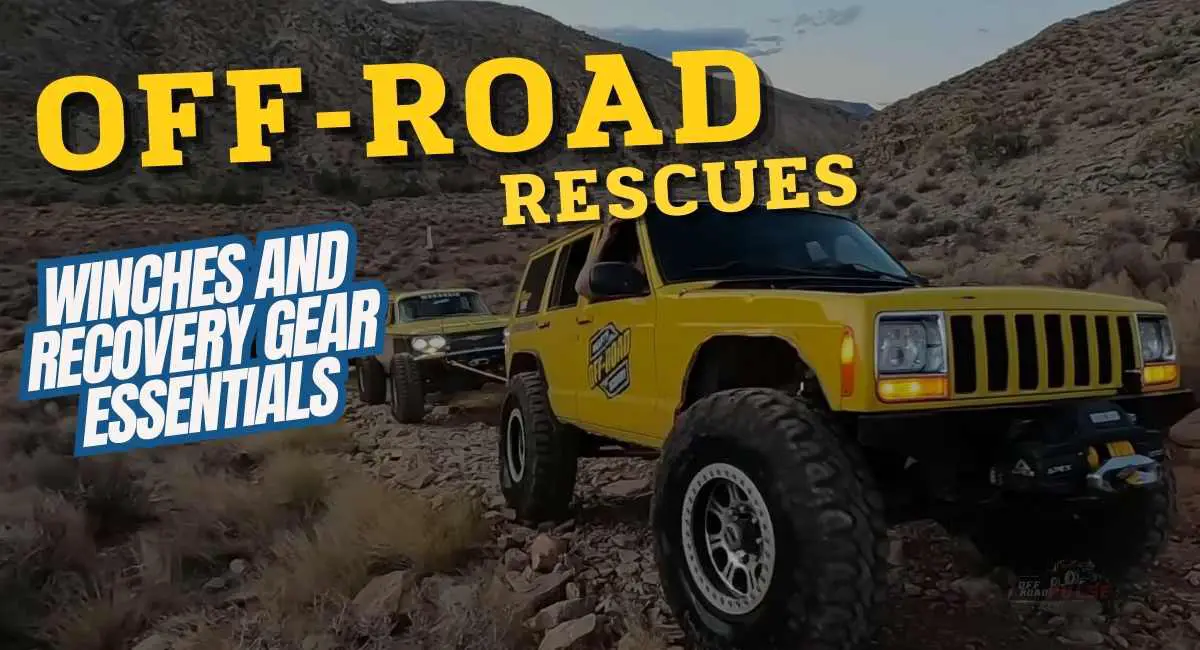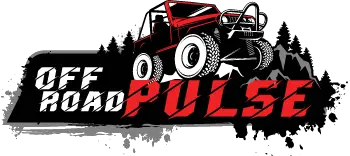Embarking on off-road adventures is a thrilling endeavor that takes enthusiasts beyond the beaten path and into the heart of nature’s rugged terrain. However, this exciting pursuit is not without its challenges, and those who dare to venture off the concrete must be equipped to face the unexpected.
As the saying goes, ‘Hope for the best but prepare for the worst.’ These words hold true, especially for off-road enthusiasts who navigate through a spectrum of obstacles, ranging from steep inclines and jagged rocks to treacherous mud pits.
When gearing up for your off-road expedition, it’s crucial to brace yourself for the challenges that might unfold during the journey. A fundamental aspect of this preparation involves putting together a comprehensive vehicle recovery kit. After all, the trails ahead aren’t always inclined to be fair.

Importance of Recovery Gear
Off-road recovery gear is essential for anyone venturing and engaging in activities, such as mud bogging, rock crawling, and overlanding. The importance of off-road recovery gear cannot be overstated, as it plays a crucial role in ensuring the safety of both the vehicle and its occupants. Here are some key reasons why off-road recovery gear is essential;
Safety
Off-road terrain can be unpredictable and challenging. Recovery gear helps enhance safety by providing the means to extract a vehicle from difficult situations.
Self-Reliance
Off-road recovery gear empowers off-road enthusiasts to handle challenging situations independently. Being self-reliant means you are less dependent on external assistance, especially in remote areas where help may be scarce.
Minimizing Damage
Off-road recovery gear allows for a controlled and careful extraction of a stuck or immobilized vehicle. This helps minimize damage to the vehicle and its components during recovery operations.
Versatility
Different off-road situations may require different types of recovery gear. Having a variety of tools and equipment ensures that you are prepared for a range of scenarios, from mud and sand recoveries to winching or jacking a vehicle over obstacles.
Efficiency
Recovery gear enables quick and efficient recovery operations. Having the right tools on hand reduces the time and effort required to get a vehicle unstuck, allowing you to continue your journey with minimal disruption.
Environmental Responsibility
Proper recovery gear usage also helps minimize environmental impact. Struggling to free a stuck vehicle without the right tools can possibly damage the terrain and vegetation. Using the right recovery gear allows for more controlled and less destructive extraction.
The Role of Winches in Off-Road Recovery
No matter how frequently you venture onto less-traveled paths, encountering a situation where your vehicle gets stuck is inevitable. The last scenario anyone wishes to face is being stranded alone in a remote area without cellular service. Hence, it becomes crucial to pack essential off-road recovery gear for every expedition.
A winch stands out as one of the most invaluable tools in your recovery arsenal. This tool is a must-have for dedicated off-road enthusiasts, given the unpredictable nature of off-road terrain, where you can never be sure when you’ll find yourself in need of its assistance.
What is a Winch?
A winch is a mechanical device designed to pull or lift heavy loads by winding and unwinding a cable or rope around a drum. It’s commonly used in various applications, including off-road recovery, to help extract stuck or immobilized vehicles.
Winches are often mounted on the front or rear of vehicles and are powered by an electric, hydraulic, or power take-off (PTO) motor. Ideally, the power is transmitted from motor to the drum, causing it to rotate. As the drum rotates, it generates the pulling force needed for vehicle recovery or lifting heavy objects.
Types of Winches
Electric Winches
Electric winches are powered by the vehicle’s electrical system, and are commonly used in off-road applications. They are known for their ease of installation, versatility, and compatibility with various recovery applications. However, it’s important to note that their usage is limited by the vehicle’s battery capacity. For instance, prolonged operation, especially during demanding recovery tasks, may contribute to battery drainage.
Hydraulic Winches
Hydraulic winches derive power from a vehicle’s power steering pump or a separate hydraulic power unit. Hydraulic winches are effective in providing steady pulling force, which makes them well-suited for tasks that require continuous and powerful winching capabilities. However, the installation process tends to be more complex compared to electric winches.
Power Take-Off (PTO) Winches
PTO winches utilize the power take-off system of a vehicle, often connected to the transmission. These winches boast high power output and consistent performance. They don’t rely on electrical systems, which provide an alternative for applications that don’t have access to electric supply. However, PTO winches may require more intricate installation and have limited compatibility with specific vehicles.
Manual Winches
Manual winches operate through manual cranking. These winches are valued for their simplicity and reliability, plus they don’t require external power sources. While they are straightforward to use, manual winches may have limited power compared to their motorized counterparts and require manual effort.
Air Winches
Air winches are powered by compressed air, making them suitable for environments where electrical or hydraulic power might not be practical or safe. However, they are less common in off-road applications, and their usage depends on the availability of a compressed air source.
Essential Recovery Gear
As we have already stated, a winch stands out as a fundamental piece of equipment on any off-road recovery gear checklist. However, a winch alone is not always sufficient. The winch requires the support of a well-curated set of recovery gear to execute successful vehicle rescues. Some of the essential recovery gear include;
I. Recovery Straps
Recovery straps are special straps that are purpose-built to assist in recovering stuck or immobilized vehicles. Recovery straps are typically made from high-strength and elastic materials to allow them to stretch and store kinetic energy during a recovery operation.
Recovery straps come in various widths and lengths, and the choice depends on the specific recovery needs and the type of vehicles involved. Generally, longer and wider straps are suitable for heavier vehicles and more challenging recovery situations.
II. Shackles
Shackles are sturdy and U-shaped metal connectors designed for linking various components in a recovery system. Shackles are used to create attachment points between recovery straps, winch cables, and anchor points to ensure a strong and reliable connection.
III. Snatch Blocks
Snatch blocks are versatile tools used in vehicle recovery to increase the pulling power and reduce load on the winch. Snatch blocks are attached to anchor points or recovery points using shackles. The winch cable passes through the snatch block’s pulley, and the block itself is secured to a stable anchor.
IV. Winch Hook
A winch hook is a component used to attach the winch cable or synthetic rope to an anchor point during recovery operations. Its primary role is to secure the connection between the winch and the vehicle being recovered.
Many winch hooks feature a latch or clip mechanism that helps keep the winch cable or synthetic rope securely attached to the hook. This latch helps to prevent accidental disengagement during the recovery process.
V. Tree Trunk Protector
A tree trunk protector is technical equipment used in off-road recovery to protect the recovery gear and the natural environment, particularly trees. Its primary purpose is to prevent damage to the trees when they are used as anchor points for winching or recovery operations. The recovery straps are often attached to the end loops of the protector to prevent direct contact between the strap/cable and the tree.
VI. Recovery boards
Recovery tracks, also known as traction boards or recovery mats, are specialized tools designed to provide traction and assist vehicles in overcoming challenging off-road terrains. They are commonly used in situations where a vehicle gets stuck in mud, sand, snow, or other soft surfaces. The primary purpose of recovery boards is to enhance a vehicle’s grip and traction, thereby allowing it to regain momentum and traction for self-recovery.
VII. Winch Extension Straps
Winch extension straps are additional lengths of synthetic or wire rope designed to extend the reach of a winch. These extension straps serve a crucial purpose in off-road vehicle recovery scenarios where the standard length of the winch cable may not be sufficient to reach a suitable anchor point.
Winching Techniques
Winching is a critical skill in off-road recovery, and understanding the proper techniques and safety measures is essential for a successful and secure vehicle recovery operation.
Step-by-Step Guide on Using a Winch for Vehicle Recovery
i. Assessment and Planning
Survey the recovery situation to evaluate the condition of the stuck vehicle. Next, identify suitable anchor points and plan the route for the winch cable. Ensure that the anchor points are stable and capable of withstanding the winching forces.
ii. Safety First
Prioritize safety for yourself and others. Ensure everyone is at a safe distance from the vehicle and recovery zones. Remember to wear appropriate safety gear, including gloves and eye protection.
iii. Secure Attachment
Ensure a reliable attachment by securely fastening the winch cable to the vehicle’s recovery points using a suitable winch hook or shackle. Verify that the attachment is not only tight but also properly aligned for optimal effectiveness.
iv. Pre-tensioning
Before applying full force, engage the winch and apply gentle tension to the cable. This ensures that the cable is properly seated on the drum and helps reduce the risk of cable slack or snarling.
v. Winching Operation
Gradually engage the winch by applying steady tension to the cable. Avoid sudden jerks or rapid movements that could jeopardize the recovery operation. Monitor the progress of the recovery and make adjustments as needed.
vi. Communication
Maintain clear communication between the operator and any spotters or bystanders. Establish hand signals or verbal cues to ensure everyone is aware of the winching operation and can communicate effectively.
vii. Directional Control
If the winch allows, control the direction of the pull using the winch controller. This is particularly important for navigating challenging terrain or obstacles.
viii. Monitoring
Monitor the winching operation continuously while keeping an eye on the condition of the winch cable. Counter-check the tension in the cable, and assess the stability of the anchor points.
ix. Leave No Trace
Minimize environmental impact by sticking to designated trails and avoiding unnecessary damage to vegetation.
x. Post-Recovery Checks
After a successful recovery, conduct post-recovery checks on the winch, cable, and other equipment. Ensure that everything is in proper working order and address any issues immediately.
Common Mistakes to Avoid During Winching
- Avoid exceeding the rated capacity of the winch. Check the vehicle weight and choose the appropriate winch for the recovery.
- Ensure proper cable tension during winching to prevent slippage or snarling. Insufficient tension can reduce the effectiveness of the recovery.
- Regularly inspect the winch, cable, and other components for wear, damage, or malfunctions. Neglecting equipment checks can lead to equipment failure during critical moments.
- Select anchor points carefully and avoid weak or unstable structures. Using unsafe anchor points can result in anchor failure and compromise the safety of the recovery operation.
- Maintain a safe distance from the winch and recovery area. Ensure bystanders stay clear to avoid accidents in case of cable snapback or equipment failure.
- Handle the winch cable with care and avoid kinks or sharp bends. Never allow the cable to slide through your hands. You can use a towel or similar material to cover the cable during recovery to minimize the risk of snapback.
Winch Maintenance Tips
- Maintaining and inspecting a winch is crucial to ensure its reliable performance, extended lifespan, and enhanced safety. Regular maintenance and inspections help identify potential issues early on and prevent costly repairs or accidents. Remember, it is always better to care than repair!
- Before and after each use, carefully check the winch cable for kinks, fraying, or any signs of damage. Consider replacing the cable promptly if you identify any issues that might compromise its effectiveness.
- Keep the winch cable dry and clean, free of dust or debris that could compromise its integrity.
- After every use, ensure that the cable is spooled neatly and evenly onto the drum. This promotes longevity and reliable performance.
- Apply lubricant to the winch’s moving parts and always follow the manufacturer’s recommendations for the type of lubricant and frequency of application.
- Every few months, inspect the electrical connections to ensure they are clean and in good working condition. Remove any dirt caught in the connections.
- Frequently check the mounting bolts to ensure they are tight and provide a sturdy connection.
- If your winch is not used regularly, power the cable in and out at least once a month. This helps inspect the cable and generates heat to prevent moisture buildup.
- Perform a load test periodically to ensure the winch can handle its rated capacity. This is particularly important for recovery winches used in heavy-duty applications.
- When not in use, cover the winch to protect it from the elements. This helps prevent corrosion and extends the lifespan of the equipment.
Conclusion
The essence of off-roading lies not just in the thrill of conquering challenging terrains but also in ensuring the safety and preparedness of every adventure. Unforeseen mishaps can occur at any moment, turning a joyous adventure into a challenging ordeal. Investing in a comprehensive vehicle recovery kit, including essential components like winches not only mitigates the risks associated with off-road exploration but also empowers you to handle emergencies with confidence and efficiency.




